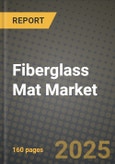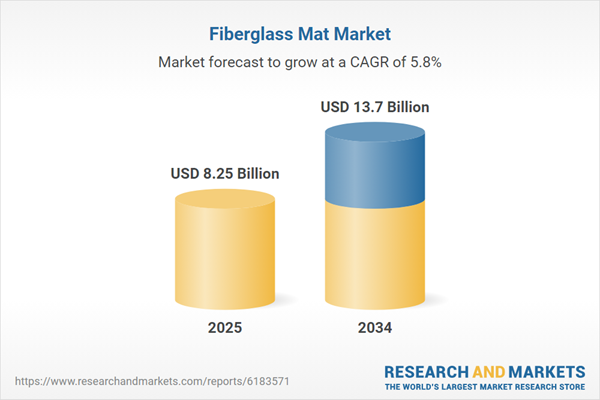Fiberglass Mat Market
Fiberglass mats are non-woven reinforcements produced from chopped strands (CSM), continuous filaments (CFM), stitched combo mats, and surface tissues/veils bound with emulsion or powder binders. They serve as versatile, formable layers that deliver isotropic properties, resin carry, and print-through control across open-mold, infusion/RTM, pultrusion, compression molding, and filament winding processes. Core end-uses include transportation body panels and structural parts, marine hulls and decks, wind blade skins and shear webs (often paired with fabrics), construction products (roofing shingles, waterproofing membranes, gypsum boards), pipes/tanks for water and chemicals, electrical insulation, and sanitaryware. Current trends emphasize infusion-compatible mats with rapid wet-out and low air entrapment; hybrid layups combining mats with multiaxial fabrics and cores; low-styrene/low-VOC resins and binder chemistries aligned to EHS requirements; and design for durability in UV, moisture, and chemical exposure. In construction, surface veils enhance corrosion resistance and aesthetics, while AR-glass and specialty veils support cementitious and architectural profiles. Supply dynamics hinge on glass fiber furnace uptime, energy costs, binder and sizing chemistry availability, and regional logistics. Competitive differentiation centers on consistent areal weight and thickness, pore structure tuned for resin flow, binder compatibility across polyester/vinyl ester/epoxy systems, and kitting/just-in-time service. Sustainability narratives - cullet usage in fiber melting, energy efficiency, recyclate incorporation, and take-back for production scrap - are gaining weight with OEMs. Medium-term growth follows wind, lightweighting in mobility, infrastructure waterproofing, and corrosion-resistant piping, tempered by resin price volatility, installation labor constraints, and qualification timelines for new mats in certified applications.Fiberglass Mat Market Key Insights
- Portfolio fit by process
- Binder chemistry matters
- Infusion and RTM momentum
- Surface quality & protection
- Hybrid stacks for performance
- Durability in harsh service
- Productivity and automation
- Sustainability signals
- Standards and qualification
- Cost and supply resilience
Fiberglass Mat Market Reginal Analysis
North America
Demand is anchored in roofing and waterproofing membranes, transportation composites, marine, and water/chemical piping. Infusion-compatible mats and corrosion-barrier veils gain share in tanks and FRP infrastructure. OEMs value kitting, short lead times, and consistent areal weights to stabilize takt. Low-styrene initiatives push binder and resin upgrades. Regional melt capacity and distributor networks buffer logistics swings.Europe
Wind, marine, and industrial equipment drive higher-spec mats with epoxy-friendly binders and tight permeability windows. Construction emphasizes surface veils for façades and waterproofing systems aligned to low-VOC rules. Circularity and LCA documentation influence sourcing. Automation and pre-cut kits reduce labor exposure in high-cost plants. Energy pricing keeps focus on furnace efficiency and supply assurance.Asia-Pacific
Largest production base for glass fiber and mats with strong consumption in marine, automotive, appliances, and building materials. Wind blade programs pull for epoxy-compatible CFM and combo mats. Rapid infrastructure growth sustains roofing and waterproofing tissues. Competitive edge comes from cost, scale, and fast customization; technical support centers aid infusion and RTM adoption.Middle East & Africa
Corrosion-resistant piping, desalination, and infrastructure waterproofing underpin steady demand. Hot, saline environments require robust barrier veils and chemical-resistant layups. Local fabrication benefits from mat suppliers offering training, pre-kits, and dependable delivery via regional hubs. Industrial diversification broadens applications beyond oil & gas.South & Central America
Water and wastewater projects, mining, and construction membranes drive baseline volumes; marine and transport add specialty demand. Currency and freight volatility favor regional inventories and flexible pack sizes. Suppliers with reliable QC, epoxy-capable binders, and kitting support win complex projects. Growing focus on low-VOC systems and jobsite productivity guides mat selection.Fiberglass Mat Market Segmentation
By End-User
- Commercial
- Residential
By Type
- Chopped strand mats
- Woven roving mats
- Continuous filament mats
- Glass veils
Key Market players
Owens Corning, Johns Manville, Saint-Gobain ADFORS, Jushi Group, Chongqing Polycomp International (CPIC), Taishan Fiberglass, 3B-the fibreglass company, AGY, Nippon Electric Glass (NEG), Nittobo (Nitto Boseki), Taiwan Glass, PFG Fiber Glass, Ahlstrom-Munksjö, Shandong Fiberglass Group, Jiangsu Changhai Composite MaterialsFiberglass Mat Market Analytics
The report employs rigorous tools, including Porter’s Five Forces, value chain mapping, and scenario-based modelling, to assess supply-demand dynamics. Cross-sector influences from parent, derived, and substitute markets are evaluated to identify risks and opportunities. Trade and pricing analytics provide an up-to-date view of international flows, including leading exporters, importers, and regional price trends.Macroeconomic indicators, policy frameworks such as carbon pricing and energy security strategies, and evolving consumer behaviour are considered in forecasting scenarios. Recent deal flows, partnerships, and technology innovations are incorporated to assess their impact on future market performance.
Fiberglass Mat Market Competitive Intelligence
The competitive landscape is mapped through proprietary frameworks, profiling leading companies with details on business models, product portfolios, financial performance, and strategic initiatives. Key developments such as mergers & acquisitions, technology collaborations, investment inflows, and regional expansions are analyzed for their competitive impact. The report also identifies emerging players and innovative startups contributing to market disruption.Regional insights highlight the most promising investment destinations, regulatory landscapes, and evolving partnerships across energy and industrial corridors.
Countries Covered
- North America - Fiberglass Mat market data and outlook to 2034
- United States
- Canada
- Mexico
- Europe - Fiberglass Mat market data and outlook to 2034
- Germany
- United Kingdom
- France
- Italy
- Spain
- BeNeLux
- Russia
- Sweden
- Asia-Pacific - Fiberglass Mat market data and outlook to 2034
- China
- Japan
- India
- South Korea
- Australia
- Indonesia
- Malaysia
- Vietnam
- Middle East and Africa - Fiberglass Mat market data and outlook to 2034
- Saudi Arabia
- South Africa
- Iran
- UAE
- Egypt
- South and Central America - Fiberglass Mat market data and outlook to 2034
- Brazil
- Argentina
- Chile
- Peru
Research Methodology
This study combines primary inputs from industry experts across the Fiberglass Mat value chain with secondary data from associations, government publications, trade databases, and company disclosures. Proprietary modeling techniques, including data triangulation, statistical correlation, and scenario planning, are applied to deliver reliable market sizing and forecasting.Key Questions Addressed
- What is the current and forecast market size of the Fiberglass Mat industry at global, regional, and country levels?
- Which types, applications, and technologies present the highest growth potential?
- How are supply chains adapting to geopolitical and economic shocks?
- What role do policy frameworks, trade flows, and sustainability targets play in shaping demand?
- Who are the leading players, and how are their strategies evolving in the face of global uncertainty?
- Which regional “hotspots” and customer segments will outpace the market, and what go-to-market and partnership models best support entry and expansion?
- Where are the most investable opportunities - across technology roadmaps, sustainability-linked innovation, and M&A - and what is the best segment to invest over the next 3-5 years?
Your Key Takeaways from the Fiberglass Mat Market Report
- Global Fiberglass Mat market size and growth projections (CAGR), 2024-2034
- Impact of Russia-Ukraine, Israel-Palestine, and Hamas conflicts on Fiberglass Mat trade, costs, and supply chains
- Fiberglass Mat market size, share, and outlook across 5 regions and 27 countries, 2023-2034
- Fiberglass Mat market size, CAGR, and market share of key products, applications, and end-user verticals, 2023-2034
- Short- and long-term Fiberglass Mat market trends, drivers, restraints, and opportunities
- Porter’s Five Forces analysis, technological developments, and Fiberglass Mat supply chain analysis
- Fiberglass Mat trade analysis, Fiberglass Mat market price analysis, and Fiberglass Mat supply/demand dynamics
- Profiles of 5 leading companies - overview, key strategies, financials, and products
- Latest Fiberglass Mat market news and developments
Additional Support
With the purchase of this report, you will receive:- An updated PDF report and an MS Excel data workbook containing all market tables and figures for easy analysis.
- 7-day post-sale analyst support for clarifications and in-scope supplementary data, ensuring the deliverable aligns precisely with your requirements.
- Complimentary report update to incorporate the latest available data and the impact of recent market developments.
This product will be delivered within 1-3 business days.
Table of Contents
Companies Mentioned
- Owens Corning
- Johns Manville
- Saint-Gobain ADFORS
- Jushi Group
- Chongqing Polycomp International (CPIC)
- Taishan Fiberglass
- 3B-the fibreglass company
- AGY
- Nippon Electric Glass (NEG)
- Nittobo (Nitto Boseki)
- Taiwan Glass
- PFG Fiber Glass
- Ahlstrom-Munksjö
- Shandong Fiberglass Group
- Jiangsu Changhai Composite Materials
Table Information
| Report Attribute | Details |
|---|---|
| No. of Pages | 160 |
| Published | November 2025 |
| Forecast Period | 2025 - 2034 |
| Estimated Market Value ( USD | $ 8.25 Billion |
| Forecasted Market Value ( USD | $ 13.7 Billion |
| Compound Annual Growth Rate | 5.8% |
| Regions Covered | Global |
| No. of Companies Mentioned | 15 |









